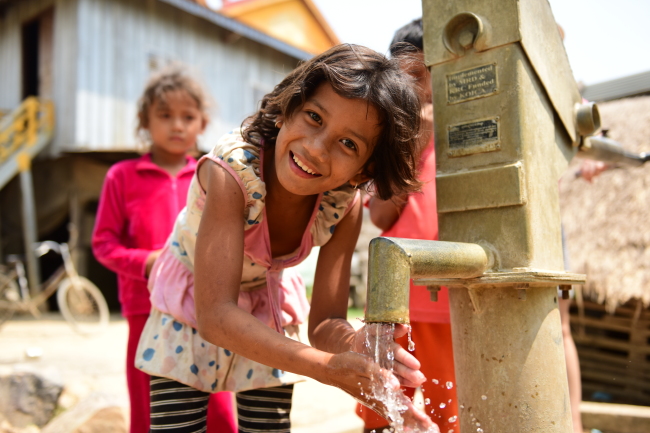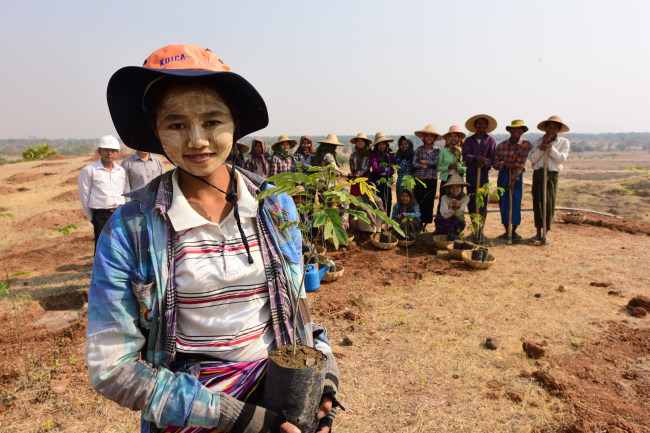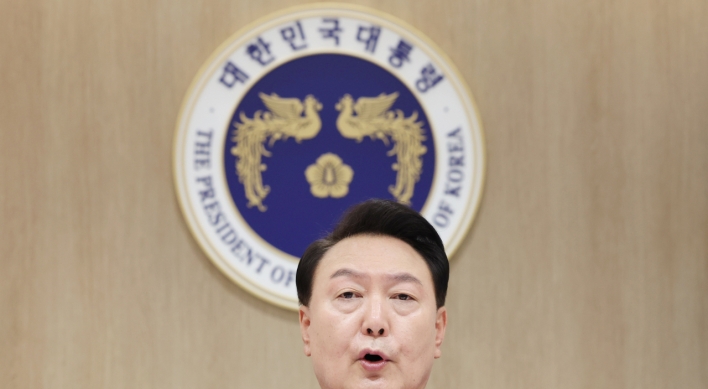Korea steps up efforts to meet global development agenda
By Shin Hyon-heePublished : Dec. 18, 2016 - 17:14
Since the country began doling out development aid in 1987, South Korea has been chiefly focusing on improving education, public administration and health in recipient countries, building on its experience from a rapid economic ascent.
Technology transfer and capacity building are the overarching theme across the sectors, given Seoul’s relatively small scale of official development assistance compared with that of countries like Japan and China which are investing heavily in infrastructure building.
Data from the Korea International Cooperation Agency shows that out of its total ODA disbursements between its 1991 founding and 2015, education accounted for the largest share with 23.5 percent, or around $1.16 billion. Public administration came second with 18.9 percent, followed by health with 16.1 percent, technology and energy with 13.1 percent, and agriculture and fisheries with 10.6 percent.
Yet in recent years, the state grant aid provider has been diversifying its project portfolio to help combat climate change, gender inequality and other emerging challenges in line with the UN Millennium Development Goals and its successor, the Sustainable Development Goals.
Technology transfer and capacity building are the overarching theme across the sectors, given Seoul’s relatively small scale of official development assistance compared with that of countries like Japan and China which are investing heavily in infrastructure building.
Data from the Korea International Cooperation Agency shows that out of its total ODA disbursements between its 1991 founding and 2015, education accounted for the largest share with 23.5 percent, or around $1.16 billion. Public administration came second with 18.9 percent, followed by health with 16.1 percent, technology and energy with 13.1 percent, and agriculture and fisheries with 10.6 percent.
Yet in recent years, the state grant aid provider has been diversifying its project portfolio to help combat climate change, gender inequality and other emerging challenges in line with the UN Millennium Development Goals and its successor, the Sustainable Development Goals.

Under its midterm framework and the SDG agenda, KOICA introduced five key initiatives last year, scaling up existing programs. They are designed to support inclusive and sustainable rural development, women empowerment, fight for infectious diseases, science and technological innovation, and environmentally friendly development.
Saemaul Movement
The Saemaul (new village) Movement is modeled on Korea’s rural and agricultural reform initiative that unfolded nationwide in the 1970-80s.
Some of its keywords are self-help, diligence and cooperation -- vital to nurturing the “Can Do” spirit. The program is designed to boost the people’s voluntary participation and ownership, while promoting governance at local and national levels.
As many countries chiefly in Asia and Africa looked to take a page from Seoul’s development book, the Korean government had long been offering training for community leaders and villagers.
With some 70 percent of the world’s poorest population living in rural areas, Seoul is now seeking to cultivate the program into a more inclusive and sustainable paradigm to better meet the SDGs, in collaboration with the UN Development Program and the Organization for Economic Cooperation and Development.
Better life for girls
Officially launched earlier this year, the initiative is intended to improve health and education for young girls in poor countries who are easily deprived of opportunities to study and have a professional career.
During a visit to Ethiopia last year, for instance, many adolescent girls were missing classes or even dropping out of school since they have to walk several hours daily to fetch water and do other household chores. Many others in Uganda said they do not to go school during their menstrual periods because they cannot afford sanitary pads and the blood often leaks onto their clothes, which boys tease them about.
In its flagship paper released in October, the UN Population Fund, the UNFPA said that a 10-year-old girl’s lifetime income may triple through empowerment, calling support for education and health care “the world’s best investment.”
Yet some 62 million adolescent girls were not in school today, while 16 million girls between the ages 6 and 11 will never even start school. That is twice the number of boys, the report noted.
Seoul earmarked $200 million through 2020 to facilitate girls’ education through the capacity building of teachers and information communication technology. While providing technical and vocational training, it is supporting health services at schools and within the communities, as well as public education to raise awareness about sexual and reproductive health services.
“A young girl’s life may be one characterized by poverty and powerlessness, or full of potential and choices,” Kim Sae-ryo, the UNFPA’s regional partnerships adviser to Korea and China, told The Korea Herald.
“A life cycle approach to development is essential -- beginning before birth itself, focusing on the needs and development of children and young persons with a special emphasis on the young girl, and thus paving the way for sustainability and prosperity well into a healthy old age.”
Safe life for all from infectious diseases
In September 2015, top health policymakers from 56 nations and multinational organizations gathered to discuss ways to achieve strong and resilient global health security systems.
With the “Seoul Declaration,” Korea unveiled a $100 million commitment to advance the Global Health Security Agenda, calling for joint efforts to achieve its targets and 11 action packages on preventing infectious diseases and enhancing overall health security.
To that end, KOICA has mapped out three action plans to support and contribute to disease control and health security in vulnerable countries, focusing on immunization, national laboratory system and workforce development.
The agency is seeking to contribute to the setup of functioning national vaccine delivery systems that ensure nationwide, effective distributions including to marginalized citizens, an adequate cold chain and standing quality control.
It also supports the national labs, saying they play a critical “surveillance and effective modern point-of-care” by conducting tests on identified outbreak specimens, while fostering a skilled health security workforce that could systemically collaborate to meet relevant international regulations.
Climate compatible development
Climate change increasingly poses a challenge to development as most developing countries experience severe natural disasters every year.
Korea helps to fight global warming with four main themes -- low carbon growth, water and disaster management, climate-smart agriculture and sustainable water management.
Its programs are designed to expand access to solar, wind, small-hydro, biofuel and other renewable energy, and share technologies for energy storage, demand response and energy efficiency.
They also promote integrated water management skills to better protect resources and respond to related disasters, while developing resilient and disaster-resistant infrastructure.
As for agriculture, Korea calls for the application of appropriate technology for low carbon and climate-resilient rural infrastructure, and the adaptive capacity for the sustainable increase of agricultural productivity and income.
To promote sustainable waste management, it adopted end-of-life management of reuse, recycling and recovery, as well as waste-to-energy conversion technologies to curb greenhouse gas emissions.
Saemaul Movement
The Saemaul (new village) Movement is modeled on Korea’s rural and agricultural reform initiative that unfolded nationwide in the 1970-80s.
Some of its keywords are self-help, diligence and cooperation -- vital to nurturing the “Can Do” spirit. The program is designed to boost the people’s voluntary participation and ownership, while promoting governance at local and national levels.
As many countries chiefly in Asia and Africa looked to take a page from Seoul’s development book, the Korean government had long been offering training for community leaders and villagers.
With some 70 percent of the world’s poorest population living in rural areas, Seoul is now seeking to cultivate the program into a more inclusive and sustainable paradigm to better meet the SDGs, in collaboration with the UN Development Program and the Organization for Economic Cooperation and Development.
Better life for girls
Officially launched earlier this year, the initiative is intended to improve health and education for young girls in poor countries who are easily deprived of opportunities to study and have a professional career.
During a visit to Ethiopia last year, for instance, many adolescent girls were missing classes or even dropping out of school since they have to walk several hours daily to fetch water and do other household chores. Many others in Uganda said they do not to go school during their menstrual periods because they cannot afford sanitary pads and the blood often leaks onto their clothes, which boys tease them about.
In its flagship paper released in October, the UN Population Fund, the UNFPA said that a 10-year-old girl’s lifetime income may triple through empowerment, calling support for education and health care “the world’s best investment.”
Yet some 62 million adolescent girls were not in school today, while 16 million girls between the ages 6 and 11 will never even start school. That is twice the number of boys, the report noted.
Seoul earmarked $200 million through 2020 to facilitate girls’ education through the capacity building of teachers and information communication technology. While providing technical and vocational training, it is supporting health services at schools and within the communities, as well as public education to raise awareness about sexual and reproductive health services.
“A young girl’s life may be one characterized by poverty and powerlessness, or full of potential and choices,” Kim Sae-ryo, the UNFPA’s regional partnerships adviser to Korea and China, told The Korea Herald.
“A life cycle approach to development is essential -- beginning before birth itself, focusing on the needs and development of children and young persons with a special emphasis on the young girl, and thus paving the way for sustainability and prosperity well into a healthy old age.”
Safe life for all from infectious diseases
In September 2015, top health policymakers from 56 nations and multinational organizations gathered to discuss ways to achieve strong and resilient global health security systems.
With the “Seoul Declaration,” Korea unveiled a $100 million commitment to advance the Global Health Security Agenda, calling for joint efforts to achieve its targets and 11 action packages on preventing infectious diseases and enhancing overall health security.
To that end, KOICA has mapped out three action plans to support and contribute to disease control and health security in vulnerable countries, focusing on immunization, national laboratory system and workforce development.
The agency is seeking to contribute to the setup of functioning national vaccine delivery systems that ensure nationwide, effective distributions including to marginalized citizens, an adequate cold chain and standing quality control.
It also supports the national labs, saying they play a critical “surveillance and effective modern point-of-care” by conducting tests on identified outbreak specimens, while fostering a skilled health security workforce that could systemically collaborate to meet relevant international regulations.
Climate compatible development
Climate change increasingly poses a challenge to development as most developing countries experience severe natural disasters every year.
Korea helps to fight global warming with four main themes -- low carbon growth, water and disaster management, climate-smart agriculture and sustainable water management.
Its programs are designed to expand access to solar, wind, small-hydro, biofuel and other renewable energy, and share technologies for energy storage, demand response and energy efficiency.
They also promote integrated water management skills to better protect resources and respond to related disasters, while developing resilient and disaster-resistant infrastructure.
As for agriculture, Korea calls for the application of appropriate technology for low carbon and climate-resilient rural infrastructure, and the adaptive capacity for the sustainable increase of agricultural productivity and income.
To promote sustainable waste management, it adopted end-of-life management of reuse, recycling and recovery, as well as waste-to-energy conversion technologies to curb greenhouse gas emissions.

In a signature project, KOICA has since 1998 been supporting reforestation in Myanmar where about 9.2 percent of its territory, or 68,000 square meters, faces increasingly severe desertification, affecting some 15 million people.
Throughout the four phases, the agency has funneled in $428 million to plant about 900,000 trees across 840 hectares, the equivalent of 1,200 football fields.
Science, technology and innovation for better life
With science, technology and innovation being a critical means of inclusive growth, Korea seeks to shore up global development efforts through a three-pronged approach.
To build the capacity of science and technology personnel, the government carries out programs in many countries to upgrade advanced technical training and engineering education, send skilled volunteers there, and run scholarship programs in Korea.
To boost innovation, Seoul provides consultation on science and technology policy and strategies to local and national agencies, while supporting research and development partnerships with Korean think tanks and universities.
To build STI capacities in developing countries, Korea helps establish platforms for private sector development, and expand partnerships with public and private entities at home and abroad.
By Shin Hyon-hee (heeshin@heraldcorp.com)
Throughout the four phases, the agency has funneled in $428 million to plant about 900,000 trees across 840 hectares, the equivalent of 1,200 football fields.
Science, technology and innovation for better life
With science, technology and innovation being a critical means of inclusive growth, Korea seeks to shore up global development efforts through a three-pronged approach.
To build the capacity of science and technology personnel, the government carries out programs in many countries to upgrade advanced technical training and engineering education, send skilled volunteers there, and run scholarship programs in Korea.
To boost innovation, Seoul provides consultation on science and technology policy and strategies to local and national agencies, while supporting research and development partnerships with Korean think tanks and universities.
To build STI capacities in developing countries, Korea helps establish platforms for private sector development, and expand partnerships with public and private entities at home and abroad.
By Shin Hyon-hee (heeshin@heraldcorp.com)












![[KH Explains] How should Korea adjust its trade defenses against Chinese EVs?](http://res.heraldm.com/phpwas/restmb_idxmake.php?idx=644&simg=/content/image/2024/04/15/20240415050562_0.jpg&u=20240415144419)






